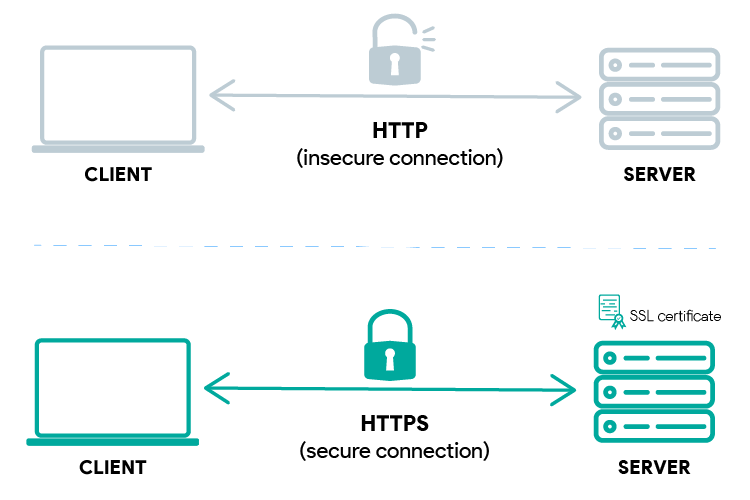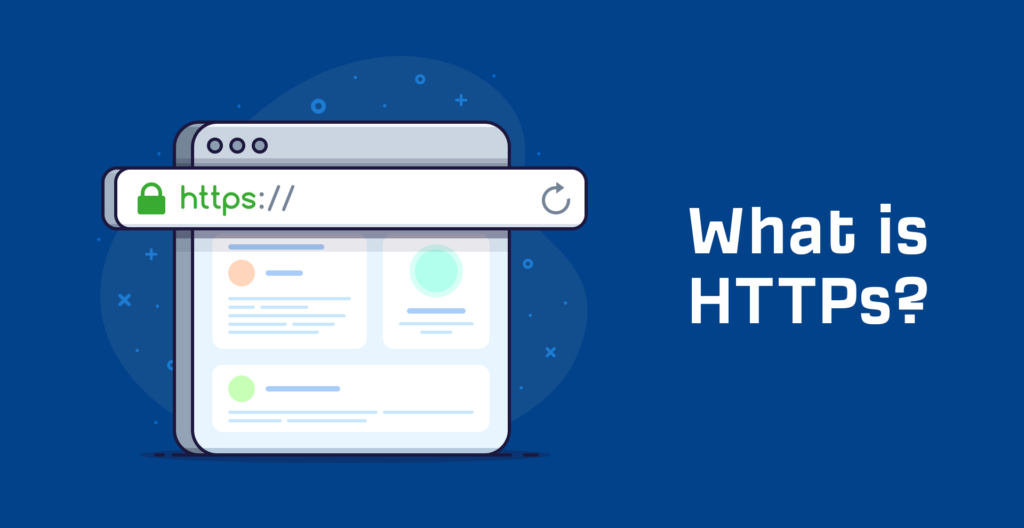(This Article has been revised, edited and added to, by Poulomi Chakraborty.)
In the vast realm of digital healthcare, where personal information and medical data intersect, the sanctity of security cannot be overstated. Much like the sealed and sterilized environment of an operating room, a medical website must be fortified against potential breaches and vulnerabilities. This is where HTTPS, or Hyper Text Transfer Protocol Secure, steps in. Not just a technical protocol, HTTPS is the very foundation of trust in the digital healthcare space. Through this guide, we will journey into understanding why HTTPS is a non-negotiable for medical websites and the manifold advantages it brings to both providers and patients.
Demystifying HTTPS: Beyond the Technical Jargon

Before diving into its significance, it’s essential to grasp what HTTPS really is and how it differs from its predecessor, HTTP.
- A Secure Layer: HTTPS is essentially HTTP with a security blanket. It employs Secure Socket Layer (SSL) or Transport Layer Security (TLS) protocols to encrypt data transferred between the website and its users.
- Guarding Data in Transit: As data traverses from servers to devices or vice versa, it becomes susceptible to interceptions or eavesdropping. HTTPS ensures this data remains undecipherable to unauthorized entities.
- A Marker of Authenticity: HTTPS isn’t just about encryption. It also verifies the website’s authenticity, ensuring users that they’re indeed communicating with the intended medical website and not an imposter.
The Strategic Imperative of HTTPS
Crafting a Culture of Security
At the heart of a successful digital healthcare startup lies not just innovative solutions but a culture of security that permeates every level of interaction. HTTPS is your first line of defense and your silent ambassador of trust. Emphasizing its role in your organization’s ethos from day one not only protects data but also builds a foundational pillar of trust with your users.
HTTPS as a Competitive Advantage
In the competitive realm of digital healthcare startups, differentiation is key. Leveraging HTTPS is not just about securing data transmission; it’s about positioning your platform as a beacon of trustworthiness and reliability. This strategic positioning can be a unique selling proposition, attracting users who are increasingly aware and concerned about their online security and privacy.
Integrating HTTPS into Your User Experience Design
Seamless Security: A Silent Guardian
While the technicalities of HTTPS ensure data security, integrating this protocol into your user experience design enhances user perception and interaction with your platform. Consider how the visibility of security measures, like the padlock icon, can be subtly integrated into your design elements, reassuring users without overwhelming them with technical jargon.
Educating Your Users: Beyond the Padlock
In an era where digital literacy varies widely among users, taking proactive steps to educate your audience about the significance of HTTPS can foster deeper trust. Creating easily accessible content that demystifies HTTPS and explains its benefits in layman’s terms can empower users, making them feel valued and secure.
Operationalizing HTTPS: A Founder’s Roadmap
Prioritizing Encryption from the Start
For startup founders, embedding HTTPS from the inception of your digital healthcare platform is not just a technical checklist item; it’s a strategic decision that sets the tone for your security posture. This means prioritizing end-to-end encryption in your development roadmap and ensuring that every element of your platform, from user interfaces to backend databases, aligns with the highest standards of data protection.
Continuous Security as a Growth Strategy
Adopting HTTPS is not a one-time task but a continuous commitment to security. Regularly updating encryption protocols, conducting security audits, and staying abreast of evolving threats are critical components of your growth strategy. This proactive approach to security can serve as a compelling narrative in your marketing and user engagement efforts, illustrating your ongoing commitment to protecting user data.
Leveraging HTTPS for Strategic Partnerships and Compliance
Building Trust with Partners and Regulators
In the healthcare sector, partnerships with other medical entities and compliance with regulatory standards are crucial for growth and operational success. HTTPS serves as a foundational element that facilitates these relationships, signaling to partners and regulators alike that your startup takes data security and patient privacy seriously. This can streamline partnership negotiations and compliance processes, opening doors to new opportunities and markets.
Preparing for a Future-Proof Digital Healthcare Ecosystem
As digital healthcare continues to evolve, so too will the standards for security and privacy. Anticipating future trends and regulatory requirements, and incorporating scalable HTTPS protocols, positions your startup as a forward-thinking leader in the space. This foresight can be a strategic advantage, enabling you to adapt swiftly to new regulations and technologies, keeping you one step ahead in the competitive landscape.
HTTPS as the Keystone of Your Digital Healthcare Strategy
For digital healthcare startups, HTTPS is more than a security protocol—it’s a strategic asset that underpins every facet of your operation, from building trust with users to navigating the complexities of regulatory compliance. By embedding HTTPS into your platform’s DNA, you not only safeguard sensitive data but also craft a compelling narrative of security, integrity, and user-centric care. As you embark on or continue your entrepreneurial journey, let HTTPS be the keystone of your digital healthcare strategy, driving growth, fostering trust, and paving the way for a secure and prosperous digital future.
Why Medical Websites Must Prioritize HTTPS
The healthcare sector is unique, given the sensitivity of the data it handles. HTTPS becomes not just a good-to-have but an imperative.
- Patient Confidentiality: From personal details to medical histories, users share intimate information with medical websites. A breach could lead to serious repercussions, both emotionally and legally.
- Building Trust: A visible indicator of HTTPS is the padlock icon next to the website’s URL. For many users, this serves as an emblem of trust, assuring them of their data’s safety.
- SEO Benefits: Beyond the user-centric benefits, search engines, particularly Google, prioritize HTTPS websites in rankings, recognizing their enhanced security protocols.
Building a Foundation of Trust with HTTPS
The Psychological Impact of Security on Patient Engagement
Trust is the cornerstone of any healthcare interaction. In the digital realm, this trust begins with the assurance of security and privacy. HTTPS is not merely a protocol but a tangible demonstration of your commitment to safeguarding patient data. By prioritizing HTTPS, you signal to your users that their well-being and privacy are your utmost concerns, thereby enhancing patient engagement and loyalty. This psychological reassurance can significantly impact the decision-making process for patients choosing between digital healthcare providers.
Strategic Brand Differentiation in a Saturated Market
In a market flooded with digital healthcare solutions, establishing a distinct and trustworthy brand identity is crucial. HTTPS serves as a strategic tool for brand differentiation, offering a clear signal of quality and reliability to patients and partners alike. This differentiation is especially critical for startups seeking to establish their footprint in the healthcare industry, where trust and security are paramount.
Leveraging HTTPS for Enhanced Patient Experience
Facilitating Secure Patient Portals and Communication
The use of patient portals and digital communication channels is on the rise, offering unprecedented convenience for both patients and healthcare providers. However, the sensitivity of the information shared through these portals demands uncompromised security. By implementing HTTPS, startups can ensure a secure environment for patients to manage their health information, communicate with healthcare providers, and make informed decisions about their care. This level of security not only protects patient data but also enhances the overall patient experience by providing a safe platform for engagement.
Driving Adoption Through Confidence in Security
For new users, the decision to engage with a digital healthcare platform often hinges on their confidence in the platform’s security measures. HTTPS plays a pivotal role in fostering this confidence, encouraging the adoption of digital healthcare services. Startups that emphasize their HTTPS implementation in their user education and marketing efforts can effectively drive user adoption rates, highlighting security as a key feature of their service.
Strategic Compliance and Risk Management
Navigating Regulatory Landscapes with HTTPS
The healthcare industry is subject to stringent regulations aimed at protecting patient data, such as HIPAA in the United States and GDPR in Europe. HTTPS is not just a best practice in this regulatory context; it’s a necessity for compliance. Startups that prioritize HTTPS from the outset position themselves favorably in the regulatory landscape, mitigating risks of non-compliance and the associated penalties. This proactive approach to compliance demonstrates a strategic understanding of the regulatory environment and its implications for digital healthcare businesses.
Mitigating Security Risks and Protecting Reputation
The potential for data breaches and cyber-attacks is an ever-present risk in the digital healthcare space. A breach can have devastating effects, not only in terms of legal and financial consequences but also in irreparable damage to a startup’s reputation. By prioritizing HTTPS, startups can significantly reduce the risk of data breaches, safeguarding both their patients’ data and their company’s reputation. This strategic risk management is crucial for maintaining the trust and confidence of patients and partners.
HTTPS as a Strategic Imperative for Healthcare Startups
For healthcare startups, prioritizing HTTPS is a strategic decision with far-reaching implications. It’s about more than just securing data; it’s about building trust, differentiating your brand, enhancing patient experience, ensuring regulatory compliance, and managing risks. In the competitive and highly regulated digital healthcare industry, HTTPS is not optional—it’s essential. By integrating HTTPS into your digital strategy from the ground up, you lay a solid foundation for a trusted, secure, and successful healthcare platform that resonates with patients and stands the test of time in a rapidly evolving digital landscape.
The Transition: Migrating from HTTP to HTTPS

For medical websites still operating on HTTP, the transition to HTTPS is a crucial step. However, this migration requires meticulous planning.
- Acquiring the SSL/TLS Certificate: Start by purchasing and installing an SSL or TLS certificate for your website. Several providers offer these certificates, with variations in validation levels and costs.
- Updating Internal Links: Post-migration, ensure all internal links point to the HTTPS versions of pages to prevent any content mismatches or errors.
- 301 Redirects: Set up 301 redirects, ensuring that users (and search engines) trying to access the HTTP version are seamlessly redirected to the HTTPS counterpart.
Strategic Planning for HTTPS Migration
Aligning Migration with Business Goals
Begin with a clear understanding of how this transition aligns with your broader business objectives. HTTPS migration should not be seen in isolation but as part of your overall strategy to enhance security, improve search engine rankings, and build patient trust. Setting clear goals for the migration can help you prioritize actions, allocate resources efficiently, and measure success against your business objectives.
Assessing the Scope and Scale of Migration
A thorough assessment of your current digital assets is crucial before embarking on the HTTPS migration. This involves cataloging all domains, subdomains, and third-party services that will be affected by the transition. Understanding the scope and scale of migration helps in planning the resources required and anticipating potential challenges during the process.
Implementing HTTPS: A Step-by-Step Approach
Choosing the Right SSL/TLS Certificate
Selecting the appropriate SSL/TLS certificate is a critical decision in the HTTPS migration process. For healthcare startups, where data sensitivity is high, opting for certificates with robust validation, such as Extended Validation (EV) certificates, can provide an added layer of trust and authenticity. Engage with reputable certificate authorities that offer the right balance of security, reliability, and customer support.
Seamless Integration and Testing
Migrating to HTTPS involves more than just installing an SSL/TLS certificate. It requires updating website configurations, redirecting traffic, and ensuring that all internal and external links are secure. Implement these changes in a staged environment to conduct comprehensive testing. This allows you to identify and resolve any issues, such as mixed content warnings or broken links, before going live. Regular monitoring and testing post-migration are essential to ensure ongoing compliance with security standards.
Maximizing the Benefits of HTTPS Migration
Enhancing SEO and Patient Experience
Leverage the SEO benefits of HTTPS migration by ensuring that all redirects are correctly implemented and that your site is reindexed by search engines as secure. This not only boosts your search engine rankings but also enhances patient experience by providing a secure and trustworthy environment for users to engage with your services.
Communicating the Transition to Stakeholders
A crucial yet often overlooked aspect of HTTPS migration is effective communication with your stakeholders, including patients, partners, and staff. Inform them of the transition and its benefits, emphasizing your commitment to security and privacy. This not only educates your audience but also reinforces trust in your brand.
Looking Beyond Migration: Continuous Security Enhancement
Regular Monitoring and Certificate Management
Post-migration, it’s imperative to establish a routine for monitoring your website’s security status and managing SSL/TLS certificates. This includes setting up alerts for certificate expiration, conducting regular security audits, and staying updated with the latest security protocols. A proactive approach to security maintenance ensures that your website remains protected against emerging threats.
Embracing Future Security Trends
As digital healthcare evolves, so do the standards and technologies for web security. Stay informed about advancements in encryption, web protocols, and cybersecurity trends. Being adaptable and forward-thinking in your security strategy ensures that your healthcare startup remains at the forefront of digital healthcare, providing safe and cutting-edge solutions to your patients.
A Strategic Blueprint for HTTPS Success
The transition from HTTP to HTTPS is a significant milestone for healthcare startups, marking a commitment to the highest standards of data security and patient privacy. By approaching this transition strategically, with careful planning, execution, and continuous improvement, startups can not only ensure a smooth migration but also leverage HTTPS as a key differentiator in the competitive digital healthcare landscape. Embrace this transition as an opportunity to strengthen your brand, build patient trust, and secure your place as a leader in the digital healthcare revolution.
Potential Pitfalls & Best Practices in HTTPS Implementation
Implementing HTTPS on medical websites is a critical step toward ensuring data security and building patient trust. However, the path to a successful HTTPS implementation is fraught with potential pitfalls. Recognizing and avoiding these pitfalls, while adhering to best practices, is essential for healthcare startups aiming to establish a secure and trustworthy digital presence.
Understanding and Mitigating Common Pitfalls
Overlooking Comprehensive Security Measures
One common misstep in HTTPS implementation is treating it as a panacea for all security concerns. While HTTPS significantly enhances data security by encrypting data in transit, it does not address other vulnerabilities, such as server-side security, user authentication processes, and protection against malware. A comprehensive security strategy that includes HTTPS as one component is crucial. Startups should adopt a holistic approach to security, implementing additional measures like firewalls, secure coding practices, and regular vulnerability assessments to ensure robust protection against a wide range of threats.
Misconfigurations and Technical Oversights
Another pitfall lies in technical misconfigurations during HTTPS setup. Incorrectly configured SSL/TLS certificates, improper redirect implementations, and neglected HTTP headers can undermine the security benefits of HTTPS. These oversights not only expose websites to security risks but also can negatively impact user experience and search engine rankings. Startups should seek expertise in HTTPS configuration or partner with reputable web hosting services that offer SSL/TLS setup and management, ensuring that the technical aspects of HTTPS are correctly implemented.
Embracing Best Practices for HTTPS Implementation
Regular Certificate Renewal and Management
SSL/TLS certificates, the backbone of HTTPS, have expiration dates. Neglecting certificate renewal can lead to website downtime and security warnings that erode user trust. Implementing an automated renewal process or maintaining a strict schedule for manual renewal ensures uninterrupted HTTPS protection. Furthermore, consider utilizing certificate transparency logs and monitoring tools to detect any unauthorized certificates issued for your domain, enhancing your security posture against potential threats.
Optimizing Performance Post-HTTPS Migration
The perception that HTTPS can slow down website performance persists, but with modern optimization techniques, this impact can be mitigated or even eliminated. Techniques such as TLS 1.3, OCSP stapling, and implementing HTTP/2 can significantly improve the speed and efficiency of encrypted connections. By focusing on performance optimization as part of the HTTPS implementation process, startups can ensure that their websites remain fast and user-friendly, enhancing the overall patient experience.
Educating and Engaging Your User Base
The transition to HTTPS provides an excellent opportunity to engage with and educate your user base about the importance of data security. Transparent communication about what HTTPS is, why it’s important, and how it benefits users reinforces trust and demonstrates your commitment to protecting patient information. This educational effort can be integrated into your website through FAQs, blog posts, or informational banners that highlight the secure nature of your platform.
Leveraging HTTPS for Strategic Advantage
Beyond Security: SEO and Brand Perception
Implementing HTTPS is not only a security measure but also a strategic move that can enhance search engine optimization (SEO) and brand perception. Google has confirmed that HTTPS is a ranking signal, and users are becoming increasingly aware of security indicators in their browsers. By highlighting your website’s secure status in marketing materials and leveraging the SEO benefits of HTTPS, startups can improve their visibility and attract more users who value security and privacy.
Preparing for the Future: HTTP/3 and Beyond
The internet is constantly evolving, with new protocols and security standards emerging. HTTP/3, the upcoming version of the Hypertext Transfer Protocol, promises even greater improvements in performance and security over HTTP/2. By staying informed about these developments and preparing to adopt them when they become widely supported, healthcare startups can ensure that their websites remain at the cutting edge of web technology and security practices.
A Strategic Path to HTTPS Mastery
For healthcare startups, the successful implementation of HTTPS is a critical milestone in establishing a secure, trustworthy, and user-friendly digital presence. By understanding and avoiding common pitfalls, adhering to best practices, and leveraging HTTPS for strategic advantage, startups can not only protect sensitive data but also enhance their competitive position in the digital healthcare marketplace. The journey to HTTPS mastery is an ongoing process of learning, adaptation, and strategic planning that underscores a startup’s commitment to security, privacy, and excellence in patient care.
Guarding Data in Transit: The Anatomy of Encryption
In the domain of digital healthcare, where the sanctity of patient information is paramount, understanding and implementing robust encryption practices are critical. As startup founders, deepening your comprehension of encryption and its strategic application can significantly enhance the security posture of your medical websites. This expanded knowledge not only fortifies data in transit but also positions your platform as a bastion of patient trust and data integrity.
The Strategic Value of Advanced Encryption
Elevating Security with Layered Encryption Strategies
Adopting a multi-layered encryption approach amplifies the security of patient data as it moves across the internet. Beyond the standard HTTPS protocol, incorporating additional encryption layers—for instance, at the application layer or within the database—ensures that data remains protected even if one layer is compromised. This strategy, known as defense in depth, is particularly relevant in healthcare, where the stakes of data breaches are exceptionally high. Startups should consider encryption at every stage of data handling, from collection and storage to transmission, as a fundamental component of their security architecture.
Tailoring Encryption to Compliance and Threat Landscapes
Understanding the regulatory compliance requirements specific to healthcare data is crucial. Regulations such as HIPAA in the United States or GDPR in Europe mandate strict data protection measures, including specific encryption standards. Aligning your encryption practices with these requirements not only ensures compliance but also offers a strategic advantage in showcasing your commitment to data protection. Moreover, staying informed about the evolving threat landscape enables startups to adapt their encryption strategies proactively, ensuring resilience against emerging threats.
Harnessing Encryption Technologies: A Closer Look
Exploring Asymmetric Encryption for Enhanced Security
While the article introduces the concept of symmetric and asymmetric encryption, diving deeper into the strategic use of asymmetric encryption can provide startups with a competitive edge. Asymmetric encryption, utilizing public and private key pairs, offers a robust mechanism for securing data exchanges even in potentially compromised environments. For medical websites, implementing asymmetric encryption for sensitive operations, such as patient authentication or the exchange of medical records, can significantly elevate the level of security and trust.
Leveraging Modern Encryption Algorithms and Protocols
The choice of encryption algorithms and protocols is pivotal in ensuring the effectiveness of your encryption strategy. With cryptographic techniques constantly evolving, selecting modern, widely-accepted algorithms such as AES (Advanced Encryption Standard) for symmetric encryption, and RSA or ECC (Elliptic Curve Cryptography) for asymmetric encryption, ensures strong data protection. Additionally, adopting the latest protocols like TLS 1.3, which offers enhanced security and performance for HTTPS connections, can further secure data in transit while providing a seamless user experience.
Strategic Implementation of Encryption in User Experience
Balancing Security with User Experience
One of the strategic challenges in implementing encryption is balancing robust security measures with a seamless user experience. Encryption processes can, in some instances, add complexity or latency to user interactions. Startups need to navigate this balance carefully, optimizing encryption implementations to minimize impact on performance while not compromising on security. Techniques such as lazy loading, efficient database encryption practices, and optimizing TLS handshakes can help achieve this balance, ensuring that user experience remains fluid and engaging.
Educating Users on the Importance of Encryption
Part of your strategic advantage lies in educating your user base about the importance and benefits of encryption. By transparently communicating how encryption protects their data, you demystify the technology and empower users to make informed decisions about their digital healthcare interactions. This educational approach can reinforce trust, enhance user engagement, and differentiate your platform in a crowded marketplace.
Encryption as a Cornerstone of Digital Healthcare Security
For healthcare startups, the strategic implementation of encryption is not just a technical necessity but a foundational element of building a trusted, secure digital healthcare ecosystem. By deepening your understanding of encryption technologies, tailoring your approach to the specific needs of the healthcare sector, and carefully balancing security with user experience, you can establish your platform as a leader in patient data protection. As the digital healthcare landscape continues to evolve, your commitment to advanced encryption practices will be a key differentiator, underscoring your dedication to the highest standards of privacy and security.

Related: Check out our free SEO suite

Building Trust: The Psychological Edge of HTTPS
Beyond the technicalities, HTTPS offers significant psychological benefits, crucial for medical websites.
- First Impressions Matter: For many users, the padlock symbol is a direct reflection of a website’s credibility. On medical websites, this tiny icon can significantly influence a user’s decision to share information or even opt for a service.
- Avoiding the ‘Not Secure’ Label: Modern browsers flag HTTP websites as ‘Not Secure’. In the healthcare domain, such a warning can be a significant deterrent, making users question the website’s authenticity and professionalism.
- Enhancing Professional Image: HTTPS isn’t just about security; it’s also a reflection of a medical entity’s commitment to staying updated with best practices and prioritizing patient safety in all domains.
The Psychology of Security: HTTPS as a Trust Signal
Creating a First Impression of Safety and Reliability
The initial interaction a user has with your medical website can significantly influence their perception of your brand. The presence of HTTPS and the visible security indicators, such as the padlock icon in the browser bar, act as immediate cues of safety and reliability. These symbols serve as non-verbal communication signals, assuring users that their data is protected. Strategic design considerations, incorporating these symbols seamlessly into the user interface, can enhance the perception of security without overwhelming users with technical details.
HTTPS as a Foundation for Emotional Engagement
Trust is not just a cognitive assessment but an emotional bond between your platform and its users. HTTPS lays the foundation for this relationship by mitigating fears and concerns about data privacy and security. By securing your site with HTTPS, you signal to users that you value and protect their most sensitive information, fostering a sense of safety and care. This emotional engagement is crucial for healthcare platforms, where users seek not only services but also reassurance and empathy in their moments of need.
Leveraging HTTPS for Brand Positioning and Loyalty
Differentiating Your Platform with a Commitment to Security
In a crowded digital healthcare market, HTTPS can be a key differentiator for your startup. Promoting your platform’s use of HTTPS in your marketing and communications strategy highlights your commitment to user security, setting you apart from competitors who may not prioritize this level of protection. This strategic positioning strengthens your brand’s reputation, attracting users who prioritize privacy and security in their healthcare decisions.
Building Long-Term Loyalty Through Consistent Security Practices
Trust, once established, needs to be maintained through consistent and transparent security practices. Regularly updating your SSL/TLS certificates, promptly addressing potential security threats, and communicating these actions to your users are all part of reinforcing the trust that HTTPS initiates. This consistency not only maintains but can also deepen user loyalty, as users come to rely on your platform’s unwavering commitment to their security and privacy.
Engaging Users Through Education and Transparency
Demystifying HTTPS for Enhanced Trust
While the presence of HTTPS is a critical trust signal, its impact can be amplified through user education. Providing clear, accessible information about what HTTPS is, how it protects user data, and why your platform has adopted it can demystify the technology for your users. This education, whether through blog posts, FAQs, or interactive guides, empowers users to make informed decisions about their healthcare interactions and enhances their trust in your platform.
Transparency as a Strategy for Trust Building
Transparency about your security practices, including the use of HTTPS, can significantly impact user trust. Openly sharing the steps your startup takes to protect user data, the regular security audits you conduct, and how you respond to potential security threats invites users into a dialogue about their safety. This openness not only reinforces the trust established by HTTPS but also positions your platform as a trusted advisor in the user’s healthcare journey.
SEO Benefits: Climbing the Search Ladder with HTTPS

The benefits of HTTPS extend to the realm of Search Engine Optimization, adding another layer of incentive for its implementation.
- Google’s Endorsement: Google has openly endorsed HTTPS as a ranking factor. While it’s one among hundreds of factors, given the competitive nature of search rankings, every advantage counts.
- Improved Referral Data: HTTPS to HTTP referral data gets lost in transition, appearing as ‘direct’ traffic in analytics. However, HTTPS to HTTPS referrals maintain their integrity, offering clearer insights into traffic sources.
- Boost in Organic Rankings: Numerous case studies have demonstrated a tangible boost in organic rankings post-HTTPS migration, leading to increased visibility and traffic.
HTTPS as a Ranking Signal: Beyond the Basics
Leveraging HTTPS for Enhanced Search Visibility
Google has explicitly recognized HTTPS as a ranking signal, rewarding websites that prioritize user security with potentially higher search rankings. For healthcare startups, transitioning to HTTPS is not just a security measure but a strategic SEO decision. By implementing HTTPS across your entire site, you signal to search engines your commitment to security, potentially boosting your visibility in search results. This enhanced visibility is particularly critical in the healthcare sector, where users often rely on search engines to find reliable and trustworthy health information and services.
The Competitive Edge in Healthcare Search Rankings
In the crowded digital healthcare market, every advantage counts. HTTPS can provide a competitive edge, distinguishing your platform from others in the eyes of search engines and users alike. Conducting a competitive analysis to understand the HTTPS usage among your competitors can reveal opportunities to outperform them in search rankings. By fully embracing HTTPS and optimizing your site’s security features, you can improve your standing in search results, attracting more traffic and establishing your platform as a secure and reputable source of healthcare information and services.
Integrating HTTPS with Overall SEO Strategy
Holistic SEO and HTTPS Integration
While HTTPS is a valuable piece in the SEO puzzle, it’s most effective when integrated into a broader SEO strategy. This includes optimizing site speed, mobile responsiveness, and user experience—all factors that search engines consider when ranking sites. HTTPS can contribute to these areas by enabling the use of HTTP/2, which can improve site speed and performance. Startups should approach HTTPS implementation as part of a comprehensive SEO plan, focusing on technical optimization, content relevance, and user engagement to fully leverage the SEO benefits of HTTPS.
Tracking and Analyzing HTTPS Impact on SEO Performance
After migrating to HTTPS, closely monitor your site’s SEO performance to understand the impact of the transition. Tools like Google Analytics and Google Search Console can provide insights into traffic patterns, engagement metrics, and search rankings before and after the HTTPS implementation. Analyzing this data allows startups to measure the effectiveness of HTTPS as an SEO strategy and make informed decisions about further optimizations. Regular monitoring also helps identify any potential issues arising from the migration, such as broken links or mixed content warnings, which can negatively affect SEO if not addressed promptly.
Communicating Security to Enhance User Trust and SEO
Highlighting HTTPS in Marketing and Communications
Beyond the technical implementation of HTTPS, communicating your site’s security features to your audience can enhance both user trust and SEO. Incorporating messages about your commitment to security in your marketing materials, social media posts, and website content can reinforce the perception of your platform as safe and trustworthy. This communication strategy not only informs users about the security measures in place but can also contribute to SEO by incorporating relevant security-related keywords and topics into your content, potentially improving your search visibility on those terms.
Building Backlinks with a Focus on Security
Backlinks from reputable sites are a cornerstone of effective SEO, signaling to search engines the credibility and authority of your website. As a secure, HTTPS-enabled site, your healthcare startup is more likely to attract high-quality backlinks from other trusted sources in the health and security sectors. Focusing your outreach and content marketing efforts on topics related to digital health security can attract attention from industry authorities, leading to backlinks that further enhance your SEO performance. Engaging with cybersecurity blogs, participating in online health forums, and publishing research on health data security are strategies to build backlinks while emphasizing your site’s secure foundation.
HTTPS as a Catalyst for SEO Success
For healthcare startups, HTTPS offers a dual advantage: it secures user data and enhances your platform’s search engine visibility. By strategically integrating HTTPS into your overall SEO strategy, communicating your commitment to security, and leveraging the protocol for a competitive edge, you can climb the search ladder and attract more users to your secure digital healthcare platform. In the journey to establish your startup as a trusted name in digital healthcare, HTTPS is a powerful tool, reinforcing both your security posture and your visibility in the increasingly important online search landscape.
The Transition: Ensuring Seamless Migration

The journey from HTTP to HTTPS, while pivotal, can be fraught with challenges. Ensuring a smooth transition is imperative.
- Backup Before You Begin: Before any significant site changes, ensure you have a complete backup. This safety net ensures you can revert to the original state in case of unforeseen issues.
- Update Google Search Console & Analytics: Post-migration, set up a new property in Google Search Console for the HTTPS version. Similarly, update your Google Analytics property settings to reflect the change.
- Monitor Performance: After the shift, closely monitor site performance, user engagement metrics, and search rankings. Any sudden dips could indicate issues that need addressing.
Strategic Planning Before Migration
Aligning HTTPS Migration with Business Objectives
Before embarking on the HTTPS migration, it’s crucial to align this process with your broader business goals. Consider how this transition will support your objectives, such as improving user trust, enhancing data security, and achieving better search engine rankings. This alignment ensures that the migration is not just a technical exercise but a strategic move that contributes to your startup’s overall success.
Comprehensive Risk Assessment
Conduct a thorough risk assessment to identify potential challenges and vulnerabilities that could arise during the migration process. This includes technical risks, such as downtime and compatibility issues, as well as business risks like temporary impacts on SEO and user experience. Understanding these risks allows you to develop mitigation strategies, ensuring a smoother transition.
Execution: Best Practices for a Smooth Transition
Phased Rollout and Testing
Instead of a full-scale immediate switch, consider a phased rollout of HTTPS across your site. This allows you to test the implementation on less critical sections of your site before extending it to more sensitive areas, such as user login and transaction pages. Phased rollout helps in identifying and addressing unforeseen issues without impacting the entire site’s operation.
Technical Considerations and Support
Ensure your team is well-versed in the technical aspects of HTTPS migration, including SSL/TLS certificate installation, configuration of web servers, and updating of content links to HTTPS. If your team lacks expertise in these areas, seeking external support or consulting with cybersecurity experts can be invaluable. This technical preparedness is crucial for avoiding common pitfalls such as mixed content issues, which can undermine the security benefits of HTTPS.
Post-Migration Strategies
Monitoring and Optimization
After migrating to HTTPS, continuous monitoring of your site’s performance, security, and search engine rankings is essential. Use tools like Google Analytics and Google Search Console to track metrics and identify areas for optimization. This ongoing analysis allows you to fine-tune your implementation, ensuring that the migration delivers the desired benefits in terms of security, SEO, and user experience.
Communication and Transparency with Users
Communicate the transition to HTTPS to your users, highlighting the benefits and your commitment to their security. This can be achieved through website notifications, email communications, and social media posts. Transparent communication not only educates your users about the importance of HTTPS but also reinforces their trust in your platform.
Leveraging Migration for Strategic Advantage
Strengthening Brand Trust and Reputation
Use the HTTPS migration as an opportunity to strengthen your brand’s trust and reputation. Highlighting your commitment to security can differentiate your startup in the competitive digital healthcare market, appealing to both users and partners who prioritize data protection.
Capitalizing on SEO and Competitive Edge
Post-migration, leverage the SEO benefits of HTTPS to gain a competitive edge. Ensure all your site’s internal links are updated to HTTPS, and re-submit your sitemap to search engines to speed up the re-crawling process. This attention to detail ensures you maximize the SEO benefits of HTTPS, improving your visibility and attracting more traffic to your secure site.
A Strategic Approach to HTTPS Migration
For healthcare startups, migrating to HTTPS is a strategic necessity that extends beyond technical implementation. It requires careful planning, execution, and post-migration strategies that align with your business objectives. By approaching this transition as an opportunity to enhance your startup’s security, trust, and competitive positioning, you can ensure not just a seamless migration but a significant step forward in your digital healthcare journey.
Potential Pitfalls: Staying Vigilant Post-migration

After successfully transitioning a medical website to HTTPS, the journey towards ensuring a secure, trustworthy platform for your users is far from over. Staying vigilant post-migration is crucial for healthcare startups aiming to solidify their reputation and user trust. This section dives deeper into potential post-migration pitfalls and provides strategic, actionable advice to navigate these challenges effectively.
Proactive Monitoring for Uninterrupted Security
Implementing Continuous Security Audits
Continuous security audits are essential for identifying vulnerabilities that could compromise your website’s integrity. Regularly scheduled audits allow you to catch and address issues before they become problematic. Incorporating automated security tools along with manual inspections can provide a comprehensive view of your site’s security health. This proactive approach not only ensures ongoing compliance with industry standards but also reinforces your commitment to user safety.
Leveraging Real-Time Monitoring Tools
Real-time monitoring tools can alert you to security threats as they happen, enabling swift action to mitigate risks. Investing in such tools helps you stay one step ahead of potential security breaches, offering peace of mind to both your team and your users. These tools can also monitor for performance issues, ensuring that your HTTPS implementation does not adversely affect site speed or user experience.
Enhancing User Experience and Performance
Optimizing for Speed and Efficiency
While HTTPS can improve security, it’s important to monitor its impact on website performance. Optimizing your site to maintain fast load times is critical, as speed directly affects user experience and search engine rankings. Techniques such as compressing images, leveraging browser caching, and minimizing HTTP requests should be part of your ongoing optimization efforts.
Addressing Mixed Content Issues
Post-migration, mixed content issues, where a secure HTTPS page contains unsecure HTTP elements, can undermine your website’s security and user trust. Conducting thorough checks and updates to ensure all content is served over HTTPS is vital. Educating your content team on the importance of using secure links and resources can help prevent these issues from arising in the future.
Strengthening Trust and Transparency with Users
Communicating Post-Migration Security Enhancements
Use the successful migration to HTTPS as an opportunity to engage with your users about the enhanced security measures you’ve implemented. Transparent communication about the steps you’ve taken to protect their data can significantly boost user trust. Consider creating dedicated sections on your website or blog posts that detail your security practices and the benefits they bring to users.
Establishing a Feedback Loop with Users
Creating channels for user feedback on website performance and security can provide valuable insights into potential issues or areas for improvement. Encouraging users to report any security concerns or performance issues they encounter fosters a sense of community and shows that you value their input and well-being. This feedback loop can also serve as an early warning system for identifying and addressing problems.
Preparing for the Future: Adaptive Security Strategies
Staying Updated with Encryption Standards
The world of digital security is constantly evolving, with new encryption standards and best practices emerging regularly. Keeping abreast of these developments and being ready to adapt your HTTPS implementation accordingly is crucial for maintaining the highest levels of security. Participating in industry forums, attending security conferences, and subscribing to security newsletters can keep you informed of the latest trends and recommendations.
Anticipating and Adapting to New Threats
Cyber threats are ever-changing, with attackers continually developing new methods to exploit vulnerabilities. An adaptive security strategy that anticipates potential threats and evolves in response is essential. Regular training for your IT team on the latest cybersecurity threats and defense mechanisms can equip them with the knowledge to protect your platform effectively.
A Commitment to Ongoing Excellence
Transitioning to HTTPS is a significant milestone for any healthcare startup, but the real work lies in maintaining and enhancing that security post-migration. By staying vigilant, continuously monitoring for threats, optimizing user experience, and fostering an environment of transparency and trust, startups can navigate post-migration challenges successfully. This strategic commitment to security and excellence not only protects your users but also solidifies your reputation as a trusted leader in the digital healthcare space.
Conclusion: HTTPS – The Bedrock of Digital Trust in Healthcare
In concluding the exploration of HTTPS as the cornerstone of digital healthcare, it’s clear that this protocol transcends its technical framework to become a fundamental pillar of trust and security in the digital healthcare ecosystem. For startups navigating the complexities of the healthcare industry, embracing HTTPS is not merely a compliance requirement but a strategic decision that signals a deep commitment to patient confidentiality, data integrity, and the overall sanctity of digital health interactions. This commitment plays a crucial role in building and sustaining trust with users, who are increasingly aware of and concerned about their digital footprint and the security of their personal health information.
As the digital healthcare landscape evolves, with advancements in technology and increasing cyber threats, the role of HTTPS in safeguarding patient data and ensuring secure communication becomes even more paramount. It is the responsibility of healthcare startups to not only implement HTTPS but to continually adapt and enhance their security measures, staying ahead of potential vulnerabilities and reinforcing their position as trustworthy custodians of patient data. In this journey, HTTPS stands as a beacon of trust, ensuring that the digital transformation of healthcare continues to advance in a secure, patient-centric manner.
READ NEXT:
- Business Going Bankrupt? Here’s What You Should Do (Indian Insolvency Law)
- Data Privacy Laws in India and Its Impact on Business
- An Overview of Special Economic Zones in India
- Core Web Vitals: Why Speed Matters for Educational Sites
- Advanced Link-Building Strategies for Educational SEO




















Comments are closed.